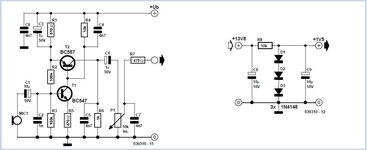neazoi
Advanced Member level 6
I have found this low voltage, low current dynamic mic preamplifier

 circuit-diagramz.com
which I built and it works fine.
circuit-diagramz.com
which I built and it works fine.
My SSB transceiver, where the preamplifier is fit in, has a "phantom power" to the preamplifier. That is only 2 cables and it passes audio in the power line, that is the way it is designed.
Problem is that this can supply low current, so any attempt to draw more current from it, drops the voltage (starting from 6v unloaded).
This preamplifier dropped the voltage to about 2v and worked fine.
But I need a little bit more gain out of it, so I do not have to shout on the microphone for full transceiver power output.
How can I get more gain out of this circuit, what modifications can I do, always having in mind the low voltage low current situation?

Simple Microphone Preamplifier Schematic Circuit Diagram
Simple Microphone Preamplifier Schematic Circuit Diagram
 circuit-diagramz.com
circuit-diagramz.com
My SSB transceiver, where the preamplifier is fit in, has a "phantom power" to the preamplifier. That is only 2 cables and it passes audio in the power line, that is the way it is designed.
Problem is that this can supply low current, so any attempt to draw more current from it, drops the voltage (starting from 6v unloaded).
This preamplifier dropped the voltage to about 2v and worked fine.
But I need a little bit more gain out of it, so I do not have to shout on the microphone for full transceiver power output.
How can I get more gain out of this circuit, what modifications can I do, always having in mind the low voltage low current situation?
